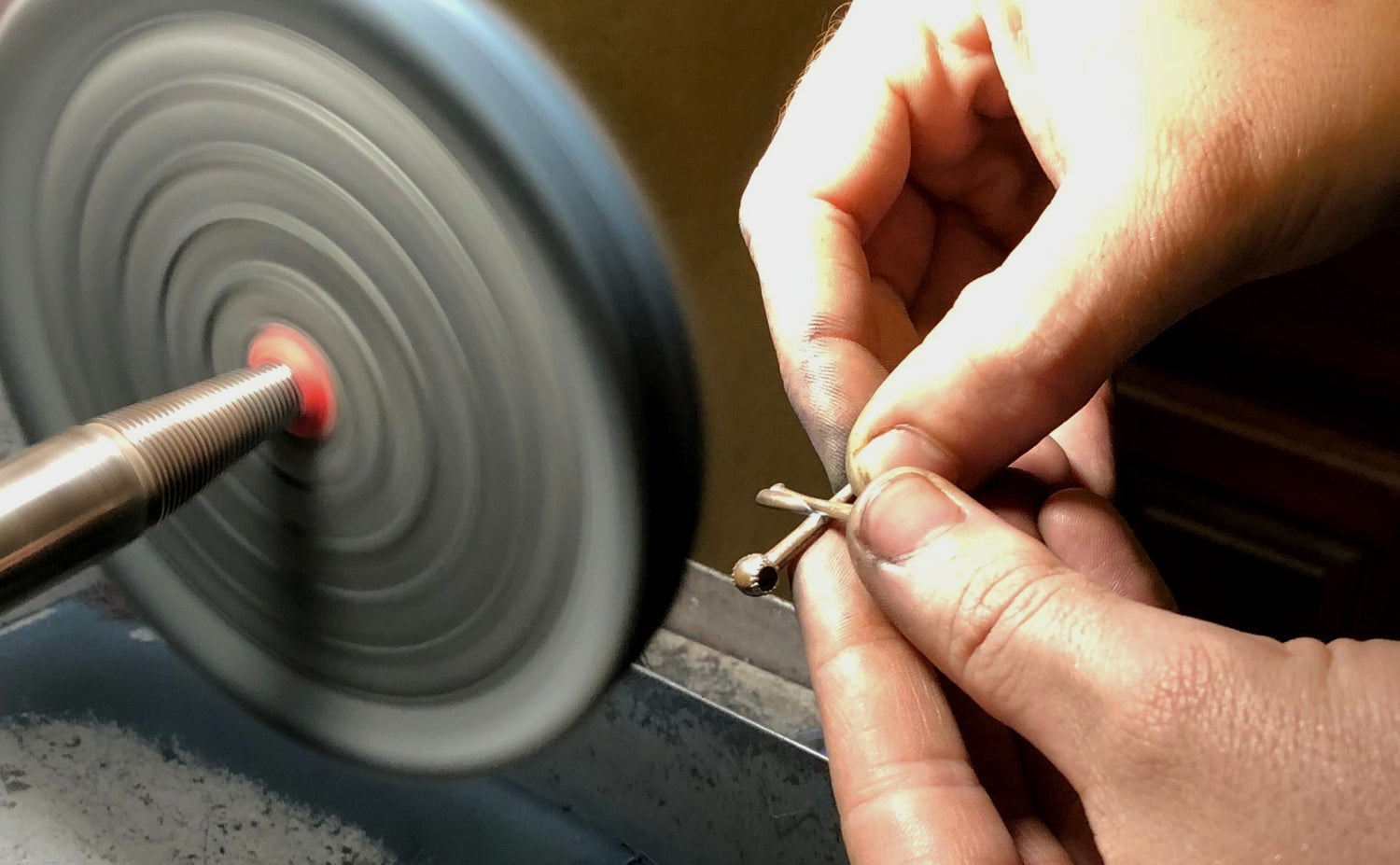Silver Tarnish…. What it is, where it comes from, and is it normal?
If you have ever noticed that your silver jewelry turns black over time you have experienced silver tarnish. Not to worry! All silver jewelry tarnishes over time. It is a completely natural phenomenon that is most definitely not the end of your sterling jewelry or flatware. While tarnishing can be annoying, it is relatively easy to remove once you know what you are up against. So, before you send your silver back to its maker, it is important to know that tarnishing silver has nothing to do with the quality of silver or the quality of the product. It has everything to do with chemistry!
So What Does Tarnish Really Mean?
Tarnishing in silver products is the result of the oxidation of the silvers surface with the air; specifically, with contaminants containing sulfur in the air. When sterling silver is exposed to general environmental conditions it begins to react with chemicals in the environment that will cause the formation of silver sulfide on the surface of the metal. Unfortunately, for jewelry owners everywhere, silver sulfide is black. As this coating continues to build on the silvers surface, the silver continues to darken, eventually turning black.
Tarnishing in silver products is the result of the oxidation of the silvers surface with the air; specifically, with contaminants containing sulfur in the air. When sterling silver is exposed to general environmental conditions it begins to react with chemicals in the environment that will cause the formation of silver sulfide on the surface of the metal. Unfortunately, for jewelry owners everywhere, silver sulfide is black. As this coating continues to build on the silvers surface, the silver continues to darken, eventually turning black.
Is Silver Tarnish Normal?
Absolutely. Silver that is used in jewelry, flatware, and other utilitarian purposes, is an alloy. Typically, these are made from sterling silver which is made from 92.5% pure silver, and 7.5% alloy, typically copper. These combinations of metals make for a metal that is reactive in the natural environment. Pure silver is much less reactive in the environment than silver alloys. However, silver in its elemental state is very soft and is not typically suitable for or used for jewelry making. Sterling silver is the jewelry industry standard and unfortunately, the alloying with copper means it will always tarnish.
How Fast Does Silver Tarnish?
The rate at which silver tarnishes is a by product of the conditions under which the metal is placed. Generally, compounds containing sulfur in the air are naturally occurring which means that sterling jewelry left unattended in the open air will tarnish naturally to a dark color. Wearing the jewelry and exposing it to sweat, lotions, perfumes, colognes, soaps, and other chemical exposures can speed up or slow down the tarnishing process. Under the right circumstances silver can begin to turn black in just a few days. In other instances, it can take many months or years.
Why Does My Silver Tarnish Faster Than Other People's?
It is important to know that silver will tarnish faster or slower depending on its environment. This also means it will tarnish at varying rates depending on the wearer. Each person has a unique bodily chemistry that can compliment or detract from the performance of sterling silver jewelry as well as other metals. Sometimes this is referred to as a silver allergy. In cases of extreme silver tarnish that occurs quickly, it is likely because the specific chemistry of the wearer forces the sterling silver to prematurely tarnish. Again, this is nothing to worry about. There are ways to combat this type of “silver allergy”. One of the easiest things to do is purchase a coating that can be applied to the jewelry when it is first purchased. These types of coatings prevent skin contact with the jewelry which can help keep your jewelry tarnish free much longer. Everbrite Coatings, a company specializing in these types of coatings, will be your best bet on keeping your skin protected. . Another alternative is to use a clear fingernail polish over the surface of the jewelry. This is effective and can be reapplied when necessary.
How To Clean Tarnished Silver
When it comes to cleaning tarnished sterling silver jewelry, there are several options and types of cleaning to consider. The primary methods for cleaning sterling jewelry is physical methods, chemical methods, or some combination of both.
Physical Cleaning
Typically, this means polishing of some sort. A physical method is one that aims to remove the silver sulfide by means of an abrasive. Popular ways to do this include using a jewelry polishing cloth or having a professional use a buffing or polishing wheel.
- Polishing cloths are pieces of fabric that have a polishing rouge embedded into the fabric to make it slightly abrasive. This allows the silver sulfide to be buffed off the piece of jewelry leaving it with a nice shine! These jewelry polishing cloths are available at most department stores for a few dollars. While these cloths are very handy and do work, it may take some serious elbow grease to remove all the tarnish. If you do not feel like spending an afternoon polishing your jewelry, read further for our second method.
- A local jeweler is always the fastest option when it comes to physical polishing methods. Locally owned jewelry stores, and some big box stores, have special polishing equipment that will make quick work of your tarnished jewelry. In many cases, if you only have one or two small pieces, jewelers will typically polish your pieces for free and it will only take a few minutes. Remember to be courteous to your jeweler. If you bring a dozen pieces to polish and demand them quickly, they are very likely to charge a high cost. This method will leave your jewelry sparkling like the day it was new! When asking a jeweler, it is important to use the right terminology because cleaning and polishing do not always have the same meaning. To learn the difference click here.
Chemical Cleaning
Chemical cleaning is just as it sounds, using some time of caustic chemical to strip away at the surface of the metal removing all the silver sulfide. Chemical cleanings are very popular methods because they can be performed at home in a short amount of time. While this is nice, be warned. Chemical cleaners typically come with very strict warnings about how long you should expose your jewelry to the cleaner. If left longer than recommended, chemical cleaners can damage your jewelry. This method of cleaning will also not polish your jewelry and restore the shine of the piece. Many cleaners, while effective at removing black tarnish, will leave the surfaces of the jewelry pitted and rough causing a dull overall appearance. For this reason, we do not recommend using jewelry chemical cleaners as the only cleaning method.
- Chemical + Physical: With this method you would combine the use of a chemical cleaner first to remove tarnish and follow it us with a physical method to restore the shine to your jewelry. If you are wanting to do this at home, the polishing cloth can be a valid option but it will still take some work to restore the shine totally.
Our recommended method? Physical polishing by a professional jeweler. Hands down this is the best thing to do for your sterling silver jewelry. Local jewelers have dedicated their careers to understanding jewelry and all of tips and tricks that go into cleaning and polishing it. If you take your piece to a local jeweler, not only will they be able to remove the tarnish from your jewelry, but they will be able to do it in the way that least harms your specific piece. Many times, you will receive it back looking as good as new for a nominal cost if any at all. Play it safe and support a local jeweler.
How To Maintain Sterling Silver Jewelry
Maintaining your jewelry is all about warding off tarnish before it begins, right? Well, sort of. For sterling jewelry, from the moment it is created the tarnishing process has already started. Maintenance in these cases is all about maintaining the appearance of your jewelry over time before the tarnishing consumes your piece entirely. Three main factors go into maintaining your sterling jewelry.
Keeping it clean!
Keeping your jewelry clean is vital to its maintenance. Now that we know what causes tarnish to form on sterling jewelry (sweat, dust, cologne, perfume, soaps, detergents, in some cases skin contact, etc…) we know how often it is exposed to tarnishing agents. Removing these contaminants is key. This can be done with a mild dish detergent and warm water. A soft bristle toothbrush could also be used. When finished make sure all the detergent has been washed clean and dry the jewelry. This can be done as often as necessary and can be done in the shower assuming your soap is sulfide free, just make sure you dry your jewelry after you are finished.
Regular polishing!
Regular polishing will not only help your jewelry tarnish more slowly, it will help keep the shine on the piece much longer. For maintenance cleaning, a polishing cloth at home is best. Used once or twice a week will add luster and remove tarnish from your sterling jewelry.
Proper storage!
Now that we know silver is continually tarnishing, whether we are wearing it or not, we can understand why proper storage is very important. There are certain special fabrics, bags, and boxes that are made for storing jewelry that will inhibit the formation of tarnish on silver as well as other jewelry. If you are serious about your jewelry, it may be wise to invest in a proper jewelry storage container!



